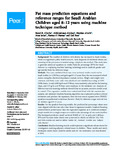Fat mass prediction equations and reference ranges for Saudi Arabian Children aged 8–12 years using machine technique method
| dc.contributor.author | Alkutbe, Rabab | |
| dc.contributor.author | Alruban, A | |
| dc.contributor.author | Alturki, H | |
| dc.contributor.author | Sattar, A | |
| dc.contributor.author | Al-Hazzaa, H | |
| dc.contributor.author | Rees, Gail | |
| dc.date.accessioned | 2021-08-09T11:23:56Z | |
| dc.date.issued | 2021-02-23 | |
| dc.identifier.issn | 2167-8359 | |
| dc.identifier.issn | 2167-8359 | |
| dc.identifier.other | e10734 | |
| dc.identifier.uri | http://hdl.handle.net/10026.1/17477 | |
| dc.description.abstract |
<jats:sec> <jats:title>Background</jats:title> <jats:p>The number of children with obesity has increased in Saudi Arabia, which is a significant public health concern. Early diagnosis of childhood obesity and screening of the prevalence is needed using a simple in situ method. This study aims to generate statistical equations to predict body fat percentage (BF%) for Saudi children by employing machine learning technology and to establish gender and age-specific body fat reference range.</jats:p> </jats:sec> <jats:sec> <jats:title>Methods</jats:title> <jats:p>Data was combined from two cross-sectional studies conducted in Saudi Arabia for 1,292 boys and girls aged 8–12 years. Body fat was measured in both studies using bio-electrical impedance analysis devices. Height and weight were measured and body mass index was calculated and classified according to CDC 2,000 charts. A total of 603 girls and 374 boys were randomly selected for the learning phase, and 153 girls and 93 boys were employed in the validation set. Analyses of different machine learning methods showed that an accurate, sensitive model could be created. Two regression models were trained and fitted with the construction samples and validated. Gradient boosting algorithm was employed to achieve a better estimation and produce the equations, then the root means squared error (RMSE) equation was performed to decrease the error. Body fat reference ranges were derived for children aged 8–12 years.</jats:p> </jats:sec> <jats:sec> <jats:title>Results</jats:title> <jats:p>For the gradient boosting models, the predicted fat percentage values were more aligned with the true value than those in regression models. Gradient boosting achieved better performance than the regression equation as it combined multiple simple models into a single composite model to take advantage of that weak classifier. The developed predictive model archived RMSE of 3.12 for girls and 2.48 boys. BF% and Fat mass index charts were presented in which cut-offs for 5th, 75th and 95th centiles are used to define ‘under-fat’, ‘normal’, ‘overfat’ and ‘subject with obesity’.</jats:p> </jats:sec> <jats:sec> <jats:title>Conclusion</jats:title> <jats:p>Machine learning models could represent a significant advancement for investigators studying adiposity-related issues in children. These models and newly developed centile charts could be useful tools for the estimation and classification of BF%.</jats:p> </jats:sec> | |
| dc.format.extent | 0-0 | |
| dc.format.medium | Electronic-eCollection | |
| dc.language | en | |
| dc.language.iso | en | |
| dc.publisher | PeerJ | |
| dc.subject | Body fat | |
| dc.subject | Children | |
| dc.subject | Obesity | |
| dc.subject | Machine learning | |
| dc.subject | Predictive equation | |
| dc.title | Fat mass prediction equations and reference ranges for Saudi Arabian Children aged 8–12 years using machine technique method | |
| dc.type | journal-article | |
| dc.type | Journal Article | |
| plymouth.author-url | https://www.webofscience.com/api/gateway?GWVersion=2&SrcApp=PARTNER_APP&SrcAuth=LinksAMR&KeyUT=WOS:000620772400002&DestLinkType=FullRecord&DestApp=ALL_WOS&UsrCustomerID=11bb513d99f797142bcfeffcc58ea008 | |
| plymouth.volume | 9 | |
| plymouth.publication-status | Published online | |
| plymouth.journal | PeerJ | |
| dc.identifier.doi | 10.7717/peerj.10734 | |
| plymouth.organisational-group | /Plymouth | |
| plymouth.organisational-group | /Plymouth/Faculty of Health | |
| plymouth.organisational-group | /Plymouth/Faculty of Health/School of Biomedical Sciences | |
| plymouth.organisational-group | /Plymouth/Research Groups | |
| plymouth.organisational-group | /Plymouth/Research Groups/Institute of Health and Community | |
| plymouth.organisational-group | /Plymouth/Research Groups/Institute of Translational and Stratified Medicine (ITSMED) | |
| plymouth.organisational-group | /Plymouth/Research Groups/Institute of Translational and Stratified Medicine (ITSMED)/CBR | |
| plymouth.organisational-group | /Plymouth/Research Groups/Plymouth Institute of Health and Care Research (PIHR) | |
| plymouth.organisational-group | /Plymouth/Users by role | |
| plymouth.organisational-group | /Plymouth/Users by role/Academics | |
| dc.publisher.place | United States | |
| dcterms.dateAccepted | 2020-12-17 | |
| dc.rights.embargodate | 2021-8-10 | |
| dc.identifier.eissn | 2167-8359 | |
| dc.rights.embargoperiod | Not known | |
| rioxxterms.versionofrecord | 10.7717/peerj.10734 | |
| rioxxterms.licenseref.uri | http://www.rioxx.net/licenses/all-rights-reserved | |
| rioxxterms.licenseref.startdate | 2021-02-23 | |
| rioxxterms.type | Journal Article/Review |


